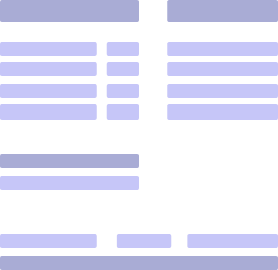Personal Bankruptcy: Your Complete Guide to Financial Reset

April 30, 2025
Personal bankruptcy is typically used as a last resort when debts become too large to handle. It allows individuals to start fresh by wiping out most of what they owe. However, the process also comes with long-term consequences, which should be considered before opting for bankruptcy.
In this article, you’ll learn how bankruptcies work and what they can and cannot do. You’ll also learn the pros and cons of the process, what the alternatives are, and how to file for it. We’ll explain what to do after filing for bankruptcy, how to rebuild your life, and how to get back on track. Let’s get started!
Key Takeaways
- Personal bankruptcy is a formal proceeding that provides individuals with legal debt relief, but it has long-term consequences.
- Most individuals should file for Chapter 7 (liquidation bankruptcy) or Chapter 13 (wage earner’s bankruptcy).
- You should always consider the alternative before filing for bankruptcy, like contacting creditors for better terms.
- During the bankruptcy process, you’ll have significant financial limitations.
- Following bankruptcy, you can rebuild your credit score and get back on your feet with careful spending and smart financial management.
What Is Personal Bankruptcy?
Personal bankruptcy is a legal process that individuals undergo when they face debt so significant that they cannot repay it. The aftermath allows for a fresh start but comes with severe consequences (e.g., a bad credit score for years). That’s why it’s critical to consider the pros and cons and look for alternatives before filing for bankruptcy.
Having the opportunity for a fresh start is not a new concept, as it dates back to the late Middle Ages. Today, most individuals can file for bankruptcy by liquidating their assets to pay some creditors and have the rest of their debt written off (Chapter 7) or retaining their assets and getting a more favorable repayment plan (Chapter 13).
What Bankruptcy Can and Cannot Fix
Individual bankruptcy is a powerful financial and legal tool, but it can’t fix everything. While there’s dischargeable debt that the court can legally erase, there’s also non-dischargeable debt that you’ll have to repay eventually.
Common examples of dischargeable debt include medical bills, credit cards, and certain types of loans. Non-dischargeable debt examples include tax debts, student loans, alimony, court fines or penalties, etc.
When filing for Chapter 7 bankruptcy, some of your assets will be exempt and won’t be liquidated. This includes personal items and clothing, tools needed for your job, part of the equity in your home and car, etc.
The rest of the assets that aren’t exempt will be liquidated. This includes properties apart from your main residence, additional vehicles, boats, collectibles and valuables, investment accounts, and more.
What to Do Before Filing for Bankruptcy
Preparation is key when filing for bankruptcy, so let’s see what you should do:
Explore All Alternative Options First
You should always explore the alternatives before filing for bankruptcy, as it can have long-lasting consequences and should be considered a last resort.
For instance, one of the first things you should do is contact your creditors and try to get better payment terms. You can even negotiate with the Internal Revenue Service and potentially get an offer in compromise, reducing the total amount of tax you owe.
If you’re unsure of your options, you should consult a certified credit counselor for assistance. They can tell you about debt consolidation loans, help you with Debt Management Plans (DMPs), and more. In some cases, you may also be able to set up informal debt repayment arrangements directly with your creditors, though these tend to be less structured than formal plans.
Prepare Your Financial Documents
If you settle on filing for personal bankruptcy, you should ensure that you have all the necessary documents beforehand.
Some of the key financial documents you should prepare, regardless of whether you’re going for Chapter 7 or Chapter 13 bankruptcy, include the following:
- Tax returns for the last 2–4 years.
- Income documentation (e.g., last two Form W-2s, profit and loss statements, bank statements, etc.).
- Proof of your property’s fair market value.
- Vehicle-related documentation.
- Retirement statements.
- Identification documents.
Additional documentation required will depend on your circumstances. For instance, if there are other factors contributing to your bankruptcy, like alimony, you should provide proof of those costs.
Major Types of Personal Bankruptcy
Most people are familiar with these three types of bankruptcies: Chapter 7, Chapter 11, and Chapter 13. Out of those, Chapters 7 and 13 are the most common types of bankruptcies for individuals, so let’s learn more about them.
Chapter 7 Bankruptcy: Liquidation Approach
Chapter 7 is also referred to as the “liquidation bankruptcy.” It involves selling a filer’s non-exempt assets to repay some of their debt to creditors. The licensed insolvency practitioner in charge of the process is a trustee appointed by a meeting of the creditors, the court, or the Secretary of State.
You typically need to pass the “means test” to determine whether you qualify for bankruptcy under Chapter 7. If the court finds that you have sufficient gross income to pay your debts, you might not be able to file for this type of bankruptcy even if you wanted to.
Chapter 13 Bankruptcy: Repayment Plan Method
Chapter 13 bankruptcy involves receiving a court-approved repayment plan for your debt. This is a viable option for individuals who want to protect some of their assets and have enough income to repay the debt over a period of three to five years.
To be eligible for Chapter 13 bankruptcy, your debt can’t be too high. Between April 1, 2025, and March 31, 2028, debt limitations are $1,580,125 for secured debt and $526,700 for unsecured debt.
How Does the Bankruptcy Filing Process Work?

Now that you know what you can lose in bankruptcies, what the alternatives are, and what the two major types of bankruptcies for individuals are, let’s show you how the filing process actually works.
Hire a Bankruptcy Attorney
It’s highly recommended to hire an experienced bankruptcy attorney to help with the process. While filing on your own (pro se filing) is possible, the complexity of the endeavor makes it essential to have a professional to guide you. Having an attorney is all the more important if you’re filing for Chapter 13 or have a large amount of assets.
Another thing to keep in mind is that bankruptcies aren’t free. Apart from extreme cases, it can be you who pays for bankruptcy, attorney fees, and court filing fees. These fees can be incorporated into Chapter 13 plans, paid via retainer when going with Chapter 7, and so on.
Court Procedures and Requirements
The bankruptcy process begins with a debtor filing a petition with the court. In the next 14 days, the debtor needs to file a certificate of credit counseling if they haven’t on the first day. Following that, they’ll have to provide tax returns to the trustee and file a statement of intention.
Between days 20 and 40 of the process, filers must attend a meeting of creditors (341(a) meeting). After that, filers must perform a Statement of Intention and complete a financial management training course. Lastly, there will be agreement reaffirmation, followed by granted discharge.
Life During the Bankruptcy Process
Life during the bankruptcy process comes with limitations, as there are some things you can not do after filing for bankruptcy.
Financial Restrictions While in Bankruptcy
You’ll face significant financial restrictions while in bankruptcy, especially under Chapter 13, which can last between 3 and 5 years. While bankrupts can have a bank account, in many cases, they’ll have to get permission to use its features.
For instance, you will not be able to use a credit card or take on debt without getting permission from the court or a trustee. Also, any time you’d want to make a major purchase (e.g., a car or property), you’d have to get approval.
Under Chapter 13, you may also be required to provide periodic reports on your income and expenses, similar to an earnings statement.
Dealing with Creditors and Collections
Bankruptcy protects you from most creditors by forbidding them from filing lawsuits, initiating repossessions and foreclosures, and more. They aren’t even allowed to contact you, and violating these court orders can result in repercussions. If you are contacted by creditors, you should report them to the court or your attorney.
However, bankruptcy doesn’t eliminate all debt. Secured debt typically remains, and you’ll have to continue making payments if you want to keep these assets.
Rebuilding After Bankruptcy
Successfully rebuilding after bankruptcy takes a disciplined and methodical approach. You should start by creating a post-bankruptcy budget to meticulously track your income and expenses, live within your means, and potentially begin to build savings.
Moreover, since credit score and bankruptcy don’t go hand-in-hand, you’ll likely be limited to a secured credit card. Make sure to use it responsibly to bring your credit score back up with a positive payment history.
By paying bills on time and avoiding large new debts, you’ll slowly reduce the negative impact of personal bankruptcy.
How Paystub.org Tools Support Financial Wellbeing

Paystub.org offers handy tools you can use to generate tax and business documents and keep track of your financial health. Maintaining clear, accurate, and organized records is critical for the bankruptcy process and the period following its closure.
You can use our Form W-2 generator to create your wage and tax statement quickly and effortlessly, whether to prepare for a bankruptcy filing or after the process. If you’re a freelancer or opt for self-employment, you can use our invoice generator to get paid like a professional.
Once you get back on your feet, you might start generating pay stubs and creating Forms 1099 to support your business endeavors.
Regardless of the document that you need, you can make it using our platform in a few simple steps:
- Select which document you want to create.
- Pick a template.
- Fill in the blanks with relevant information.
- Check out and download the document.
This way, you’ll get an expertly made financial document in a fraction of the time it would take you to create it from scratch.
Final Thoughts
Most bankruptcies are caused by loss of income, medical expenses, mortgages, overspending, and lending money to loved ones. These events can happen to anyone, which is why bankruptcy is common, while recovering from it can be challenging.
Remember that opting for personal bankruptcy should be your last resort, and you should consider the alternatives and consult the experts before doing so. Still, when used adequately, it can be a strong financial tool that can help you make a fresh financial start and get back on your feet before you know it!
Personal Bankruptcy FAQ
#1. How long will bankruptcy stay on my credit report?
Bankruptcy stays on your credit report for up to seven or ten years, depending on the type. It remains for seven years in the case of Chapter 13 bankruptcy and ten years in the case of Chapter 7 bankruptcy.
#2. Can I keep my house and car if I file for bankruptcy?
Yes, in most cases, you can keep your house and car if you file for bankruptcy. Even if you file for Chapter 7, which mandates asset liquidation, you’ll keep your main house and car. Other properties and vehicles are non-exempt assets and will likely be sold.
#3. Which debts cannot be discharged through bankruptcy?
The most common debts that cannot be discharged through bankruptcy include obligations toward domestic support (e.g., alimony and child support), student loans (except in particularly difficult cases), and tax debts. Other non-dischargeable debts can be related to criminal fines, DUI incidents, fraud, etc.
#4. Will everyone know if I file for bankruptcy?
Your bankruptcy filings are public court records, but the information won’t be explicitly shared with everyone. Relevant creditors will be notified, as well as potential lenders who will look at your credit reports. The general public typically won’t know.


